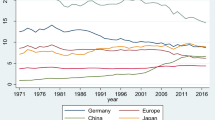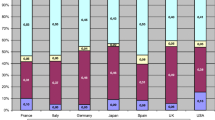Abstract
This article studies the short-term effects of energy price hikes on the supply of industrial goods and transport services including the repercussions on remuneration of input factors. The empirical analysis is based on a theoretical model, which assumes that the output good is produced by capital, labour and energy according to a nested production function framework where capital and energy are combined by a CES function at the intermediate stage. The output responses to energy price changes are derived, using estimates of the elasticity of substitution. While industry suffered more from the oil price shock of the late 1970s than from that of the early 1970s and the 2004–2008 upsurge, evidence suggests the reverse for transportation. Regarding the impact on income distribution, both sectors share the same pattern, whereby in the recent episode, rising energy costs were more than compensated by falling unit labour costs, while in the 1970s, cost structures had been strained by an expansive wage policy in addition to the oil price shocks.
Similar content being viewed by others
References
Atkeson A, Kehoe PJ (1999) Models of energy use: putty–putty versus putty–clay. Am Econ Rev 89(4): 1028–1043
Barro RJ, Sala-i-Martin X (1995) Economic growth. McGraw-Hill, New York
Berndt ER, Wood DO (1975) Technology, prices, and the derived demand for energy. Rev Econ Stat 57(3): 259–268
Chirinko RS (2008) σ: the long and short of it. J Macroecon 30: 671–686
Deutsche Bundesbank (2007) Investment activity in Germany under the influence of technological change and competition among production locations. Monthly Report, January 2007, pp 17–30
Engle RF, Granger CWJ (1987) Co-integration and error correction: representation, estimation, and testing. Econometrica 55(2): 251–276
Hamilton JD (1983) Oil and the macroeconomy since World War II. J Polit Econ 91(2): 228–248
Hamilton JD (2003) What is an oil shock?. J Econom 113: 363–398
Hamilton JD (2009) Causes and consequences of the oil shock of 2007–08. Brookings Papers on Econ Activity, Spring 2009, pp 215–261
Hamilton JD (2011) Nonlinearities and the macroeconomic effects of oil prices. Macroecon Dynamics, forthcoming
Hansen BE (1992) Tests for parameter stability in regressions with I(1) processes. J Bus Econ Stat 10(3): 321–335
Herrera AM, Lagalo LG, Wada T (2011) Oil price shocks and industrial production: is the relationship linear? Macroecon Dynamics, forthcoming
Hooker MA (1996) What happened to the oil price–macroeconomy relationship?. J Monetary Econ 38: 195–213
Kemfert C (2000) Estimated substitution elasticities of a nested CES production function approach for Germany. Energy Econ 20: 249–264
Kemfert C, Welsch H (1998) Energy–capital–labor substitution and the economic effects of CO2 abatement: evidence for Germany. J Policy Model 22(6): 641–660
Kilian L (2008a) Exogenous oil supply shocks: how big are they and how much do they matter for the U.S. economy?. Rev Econ Stat 90(2): 216–240
Kilian L (2008b) A comparison of the effects of exogenous oil supply shocks on output and inflation in the G7 countries. J Eur Econ Assoc 6(1): 78–121
Kilian L, Vigfusson RJ (2011) Nonlinearities in the oil price–output relationship. Macroecon Dynamics, forthcoming
Klump R, de la Grandeville O (2000) Economic growth and the elasticity of substitution: two theorems and some suggestions. Am Econ Rev 90(1): 282–291
Klump R, Preissler H (2000) CES production functions and economic growth. Scand J Econ 102(1): 41–56
Lucke B (2005) Is Germany’s GDP trend-stationary? A measurement-with-theory approach. Jahrb Natl Stat 225(1): 60–76
MacKinnon JG (1991) Critical values for cointegration tests. In: Engle RF, Granger CWJ (eds) Long-run economic relationships: readings in cointegration. Oxford University Press, Oxford, pp 267–276
Pindyck RS, Rotemberg JJ (1983) Dynamic factor demands and the effects of energy price shocks. Am Econ Rev 73(5): 1066–1079
Thompson P, Taylor TG (1995) The capital–energy substitutability debate: a new look. Rev Econ Stat 77: 565–568
van der Werf E (2008) Production functions for climate policy modeling: an empirical analysis. Energy Econ 30: 2964–2979
Author information
Authors and Affiliations
Corresponding author
Rights and permissions
About this article
Cite this article
Knetsch, T.A., Molzahn, A. Supply-side effects of strong energy price hikes in German industry and transportation. Empir Econ 43, 1215–1238 (2012). https://doi.org/10.1007/s00181-011-0515-7
Received:
Accepted:
Published:
Issue Date:
DOI: https://doi.org/10.1007/s00181-011-0515-7




